Hitchhiker’s Guide To The Galaxy: Episode 12
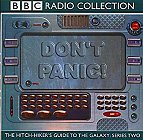 The 12th episode of Douglas Adams’ breakthrough radio science fiction comedy series The Hitchhiker’s Guide To The Galaxy is first broadcast on BBC Radio, ending the second series of the now-hit cult science fiction phenomenon. The conclusion of this episode effectively ends the series, though this ending is ignored by all later Hitchhiker’s Guide media, including the 21st century revival of the radio series, which will take its cues from Adams’ post-radio-series novels. Jonathan Pryce, Rula Lenska, and Ken Campbell guest star.
The 12th episode of Douglas Adams’ breakthrough radio science fiction comedy series The Hitchhiker’s Guide To The Galaxy is first broadcast on BBC Radio, ending the second series of the now-hit cult science fiction phenomenon. The conclusion of this episode effectively ends the series, though this ending is ignored by all later Hitchhiker’s Guide media, including the 21st century revival of the radio series, which will take its cues from Adams’ post-radio-series novels. Jonathan Pryce, Rula Lenska, and Ken Campbell guest star.
More about The Hitchhiker’s Guide To The Galaxy in the LogBook
Hitchhiker’s Guide To The Galaxy: Episode 11
 The 11th episode of Douglas Adams’ breakthrough radio science fiction comedy series The Hitchhiker’s Guide To The Galaxy is first broadcast on BBC Radio, continuing the second series of the now-hit cult science fiction phenomenon. At this point, the story has diverged into material that will not be repeated in later iterations of Hitchhiker’s Guide; Rula Lenska guest stars.
The 11th episode of Douglas Adams’ breakthrough radio science fiction comedy series The Hitchhiker’s Guide To The Galaxy is first broadcast on BBC Radio, continuing the second series of the now-hit cult science fiction phenomenon. At this point, the story has diverged into material that will not be repeated in later iterations of Hitchhiker’s Guide; Rula Lenska guest stars.
More about The Hitchhiker’s Guide To The Galaxy in the LogBook
Hitchhiker’s Guide To The Galaxy: Episode 10
 The tenth episode of Douglas Adams’ breakthrough radio science fiction comedy series The Hitchhiker’s Guide To The Galaxy is first broadcast on BBC Radio, continuing the second series of the now-hit cult science fiction phenomenon. At this point, the story diverges into material that will not be repeated in later iterations of Hitchhiker’s Guide; Rula Lenska and John Le Mesurier guest star.
The tenth episode of Douglas Adams’ breakthrough radio science fiction comedy series The Hitchhiker’s Guide To The Galaxy is first broadcast on BBC Radio, continuing the second series of the now-hit cult science fiction phenomenon. At this point, the story diverges into material that will not be repeated in later iterations of Hitchhiker’s Guide; Rula Lenska and John Le Mesurier guest star.
More about The Hitchhiker’s Guide To The Galaxy in the LogBook
Hitchhiker’s Guide To The Galaxy: Episode 9
 The ninth episode of Douglas Adams’ breakthrough radio science fiction comedy series The Hitchhiker’s Guide To The Galaxy is first broadcast on BBC Radio, continuing the second series of the now-hit cult science fiction phenomenon. (Some elements of the second radio series will go on to form the basis of Adams’ novel The Restaurant At The End Of The Universe.)
The ninth episode of Douglas Adams’ breakthrough radio science fiction comedy series The Hitchhiker’s Guide To The Galaxy is first broadcast on BBC Radio, continuing the second series of the now-hit cult science fiction phenomenon. (Some elements of the second radio series will go on to form the basis of Adams’ novel The Restaurant At The End Of The Universe.)
More about The Hitchhiker’s Guide To The Galaxy in the LogBook
Hitchhiker’s Guide To The Galaxy: Episode 8
 The eighth episode of Douglas Adams’ breakthrough radio science fiction comedy series The Hitchhiker’s Guide To The Galaxy is first broadcast on BBC Radio, continuing the second series of the now-hit cult science fiction phenomenon. (Some elements of the second radio series will go on to form the basis of Adams’ novel The Restaurant At The End Of The Universe.) Valentine Dyall (Doctor Who’s Black Guardian) guest stars.
The eighth episode of Douglas Adams’ breakthrough radio science fiction comedy series The Hitchhiker’s Guide To The Galaxy is first broadcast on BBC Radio, continuing the second series of the now-hit cult science fiction phenomenon. (Some elements of the second radio series will go on to form the basis of Adams’ novel The Restaurant At The End Of The Universe.) Valentine Dyall (Doctor Who’s Black Guardian) guest stars.
More about The Hitchhiker’s Guide To The Galaxy in the LogBook
Hitchhiker’s Guide To The Galaxy: Episode 7
 The seventh episode of Douglas Adams’ breakthrough radio science fiction comedy series The Hitchhiker’s Guide To The Galaxy is first broadcast on BBC Radio, initiating the second series of the now-hit cult science fiction phenomenon, the rest of which won’t be broadcast until the following month. This episode serves as a kind of Hitchhiker’s holiday special as a result. (Some elements of the second radio series will go on to form the basis of Adams’ novel The Restaurant At The End Of The Universe.)
The seventh episode of Douglas Adams’ breakthrough radio science fiction comedy series The Hitchhiker’s Guide To The Galaxy is first broadcast on BBC Radio, initiating the second series of the now-hit cult science fiction phenomenon, the rest of which won’t be broadcast until the following month. This episode serves as a kind of Hitchhiker’s holiday special as a result. (Some elements of the second radio series will go on to form the basis of Adams’ novel The Restaurant At The End Of The Universe.)
More about The Hitchhiker’s Guide To The Galaxy in the LogBook
Alien Worlds: The Keeper Of Eight, Part 2
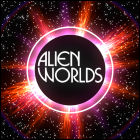 The tenth episode of Lee Hansen’s syndicated science fiction/space opera radio series Alien Worlds airs on American radio stations. Janet Waldo (The Jetsons, Battle Of The Planets) and Pete Renaday (Transformers, Teenage Mutant Ninja Turtles) guest star.
The tenth episode of Lee Hansen’s syndicated science fiction/space opera radio series Alien Worlds airs on American radio stations. Janet Waldo (The Jetsons, Battle Of The Planets) and Pete Renaday (Transformers, Teenage Mutant Ninja Turtles) guest star.
Alien Worlds: The Keeper Of Eight, Part 1
 The ninth episode of Lee Hansen’s syndicated science fiction/space opera radio series Alien Worlds airs on American radio stations. Janet Waldo (The Jetsons, Battle Of The Planets) and Pete Renaday (Transformers, Teenage Mutant Ninja Turtles) guest star.
The ninth episode of Lee Hansen’s syndicated science fiction/space opera radio series Alien Worlds airs on American radio stations. Janet Waldo (The Jetsons, Battle Of The Planets) and Pete Renaday (Transformers, Teenage Mutant Ninja Turtles) guest star.
Alien Worlds: Resurrectionists Of Lethe, Part 2
 The eighth episode of Lee Hansen’s syndicated science fiction/space opera radio series Alien Worlds airs on American radio stations. Hans Conried guest stars.
The eighth episode of Lee Hansen’s syndicated science fiction/space opera radio series Alien Worlds airs on American radio stations. Hans Conried guest stars.
Alien Worlds: Resurrections Of Lethe, Part 1
 The seventh episode of Lee Hansen’s syndicated science fiction/space opera radio series Alien Worlds airs on American radio stations. Hans Conried guest stars.
The seventh episode of Lee Hansen’s syndicated science fiction/space opera radio series Alien Worlds airs on American radio stations. Hans Conried guest stars.
Alien Worlds: Night Riders Of Kalimar, Part 2
 The sixth episode of Lee Hansen’s syndicated science fiction/space opera radio series Alien Worlds airs on American radio stations. Phil Diskin guest stars.
The sixth episode of Lee Hansen’s syndicated science fiction/space opera radio series Alien Worlds airs on American radio stations. Phil Diskin guest stars.
Alien Worlds: Night Riders Of Kalimar, Part 1
 The fifth episode of Lee Hansen’s syndicated science fiction/space opera radio series Alien Worlds airs on American radio stations. Phil Diskin guest stars.
The fifth episode of Lee Hansen’s syndicated science fiction/space opera radio series Alien Worlds airs on American radio stations. Phil Diskin guest stars.
Alien Worlds: The Starsmith Project, Part 2
 The fourth episode of Lee Hansen’s syndicated science fiction/space opera radio series Alien Worlds airs on American radio stations. Francis Bay guest stars.
The fourth episode of Lee Hansen’s syndicated science fiction/space opera radio series Alien Worlds airs on American radio stations. Francis Bay guest stars.
Alien Worlds: The Starsmith Project, Part 1
 The third episode of Lee Hansen’s syndicated science fiction/space opera radio series Alien Worlds airs on American radio stations. Francis Bay guest stars.
The third episode of Lee Hansen’s syndicated science fiction/space opera radio series Alien Worlds airs on American radio stations. Francis Bay guest stars.
Alien Worlds: The Sunstealers, Part 1
 The second episode of Lee Hansen’s syndicated science fiction/space opera radio series Alien Worlds airs on American radio stations. The series stars Linda Gary, Bruce Phillip Miller, Corey Burton and Roger Dressler.
The second episode of Lee Hansen’s syndicated science fiction/space opera radio series Alien Worlds airs on American radio stations. The series stars Linda Gary, Bruce Phillip Miller, Corey Burton and Roger Dressler.
Alien Worlds: The Sunstealers, Part 1
 The first episode of Lee Hansen’s syndicated science fiction/space opera radio series Alien Worlds airs on several American radio stations. The series stars Linda Gary, Bruce Phillip Miller, Corey Burton and Roger Dressler.
The first episode of Lee Hansen’s syndicated science fiction/space opera radio series Alien Worlds airs on several American radio stations. The series stars Linda Gary, Bruce Phillip Miller, Corey Burton and Roger Dressler.
More about Alien Worlds in the LogBook
Hear about it on the Sci-Fi 5 podcast
Hitchhiker’s Guide To The Galaxy: Episode 6
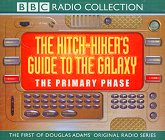 The sixth episode of Douglas Adams’ breakthrough radio science fiction comedy series The Hitchhiker’s Guide To The Galaxy is first broadcast on BBC Radio. This is the second episode co-written by John Lloyd, though his contributions are frequently downplayed by Adams in later years. Due to the unexpected popularity of the six-episode series, the BBC asks Adams for more Hitchhiker’s Guide, but in the interim he has also taken on a new full-time job as script editor of Doctor Who, making it harder to simultaneously write another six-episode radio series.
The sixth episode of Douglas Adams’ breakthrough radio science fiction comedy series The Hitchhiker’s Guide To The Galaxy is first broadcast on BBC Radio. This is the second episode co-written by John Lloyd, though his contributions are frequently downplayed by Adams in later years. Due to the unexpected popularity of the six-episode series, the BBC asks Adams for more Hitchhiker’s Guide, but in the interim he has also taken on a new full-time job as script editor of Doctor Who, making it harder to simultaneously write another six-episode radio series.
More about The Hitchhiker’s Guide To The Galaxy in the LogBook
Hitchhiker’s Guide To The Galaxy: Episode 5
 The fifth episode of Douglas Adams’ breakthrough radio science fiction comedy series The Hitchhiker’s Guide To The Galaxy is first broadcast on BBC Radio. Roy Hudd guest stars. This is the first of two episodes co-written by John Lloyd, though his contributions are frequently downplayed by Adams in later years.
The fifth episode of Douglas Adams’ breakthrough radio science fiction comedy series The Hitchhiker’s Guide To The Galaxy is first broadcast on BBC Radio. Roy Hudd guest stars. This is the first of two episodes co-written by John Lloyd, though his contributions are frequently downplayed by Adams in later years.
More about The Hitchhiker’s Guide To The Galaxy in the LogBook
Hitchhiker’s Guide To The Galaxy: Episode 4
 The fourth episode of Douglas Adams’ breakthrough radio science fiction comedy series The Hitchhiker’s Guide To The Galaxy is first broadcast on BBC Radio. Richard Vernon and Jim Broadbent guest star.
The fourth episode of Douglas Adams’ breakthrough radio science fiction comedy series The Hitchhiker’s Guide To The Galaxy is first broadcast on BBC Radio. Richard Vernon and Jim Broadbent guest star.
More about The Hitchhiker’s Guide To The Galaxy in the LogBook
Hitchhiker’s Guide To The Galaxy: Episode 2
 The second episode of Douglas Adams’ breakthrough radio science fiction comedy series The Hitchhiker’s Guide To The Galaxy is first broadcast on BBC Radio 2. Mark Wing-Davey plays the role of Zaphod Beeblebrox for the first time, a character he will also go on to play in the series’ television incarnation.
The second episode of Douglas Adams’ breakthrough radio science fiction comedy series The Hitchhiker’s Guide To The Galaxy is first broadcast on BBC Radio 2. Mark Wing-Davey plays the role of Zaphod Beeblebrox for the first time, a character he will also go on to play in the series’ television incarnation.
More about The Hitchhiker’s Guide To The Galaxy in the LogBook
Don’t Panic
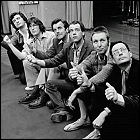 With the BBC giving his creation a late-night time slot indicating that they don’t really know what to do with it, Douglas Adams bursts onto the scene with the premiere of his radio series The Hitchhiker’s Guide To The Galaxy. Another attempt at mixing comedy and science fiction, Adams’ densely-worded style of wit catches on with an audience that’s never heard anything like it before. Hitchhiker’s Guide goes on to conquer nearly every medium exposed to it in the years to come.
With the BBC giving his creation a late-night time slot indicating that they don’t really know what to do with it, Douglas Adams bursts onto the scene with the premiere of his radio series The Hitchhiker’s Guide To The Galaxy. Another attempt at mixing comedy and science fiction, Adams’ densely-worded style of wit catches on with an audience that’s never heard anything like it before. Hitchhiker’s Guide goes on to conquer nearly every medium exposed to it in the years to come.
More about The Hitchhiker’s Guide To The Galaxy in the LogBook
Hear about it on the Sci-Fi 5 podcast
From Weather Radio to Disaster Radio
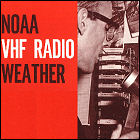 After years of studies into the feasibility of constructing a nationwide disaster alert system, NOAA Weather Radio is officially designated the “sole government operated radio system” for both weather-related disasters and other major emergency announcements (nuclear attacks are specifically mentioned in the declaration from President Ford). This shift in policy toward using the National Weather Service’s radio infrastructure for all potential disaster situations is at least partially inspired by the April 1974 tornado “Super Outbreak” in the midwest. For the first time, Congress approves a budget earmarked specifically for weather radio, topping $3,000,000 for expansion in 1976.
After years of studies into the feasibility of constructing a nationwide disaster alert system, NOAA Weather Radio is officially designated the “sole government operated radio system” for both weather-related disasters and other major emergency announcements (nuclear attacks are specifically mentioned in the declaration from President Ford). This shift in policy toward using the National Weather Service’s radio infrastructure for all potential disaster situations is at least partially inspired by the April 1974 tornado “Super Outbreak” in the midwest. For the first time, Congress approves a budget earmarked specifically for weather radio, topping $3,000,000 for expansion in 1976.
The voice of the National Weather Service
 The National Weather Service’s NOAA Weather Radio system finally finds its purpose with the introduction of a piercing “warning tone” preceding emergency weather announcements such as severe weather warnings. Manufacturers of weather radio receivers (an item which hit the market in 1970) use the five-second burst of 1050Hz warning tone to trigger attention-grabbing alert sounds and then activate the radio so the relevant information can be heard. NOAA Weather Radio broadcasts on 29 stations around the country, and the agency continues to bring new transmitters online throughout the year.
The National Weather Service’s NOAA Weather Radio system finally finds its purpose with the introduction of a piercing “warning tone” preceding emergency weather announcements such as severe weather warnings. Manufacturers of weather radio receivers (an item which hit the market in 1970) use the five-second burst of 1050Hz warning tone to trigger attention-grabbing alert sounds and then activate the radio so the relevant information can be heard. NOAA Weather Radio broadcasts on 29 stations around the country, and the agency continues to bring new transmitters online throughout the year.
The national emergency that wasn’t
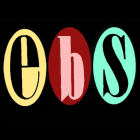 A simple accidental tape swap at the Emergency Broadcast System‘s point of origination at NORAD replaces a routine Saturday morning EBS test with an actual emergency message involving a national emergency and an imminent message from the White House. In accordance with FCC rules, numerous radio and television stations across the country interrupt their programming in anticipation of news of a national emergency that isn’t actually happening. The situation is corrected within an hour, though questions about the effectiveness of the EBS linger at the local and national levels.
A simple accidental tape swap at the Emergency Broadcast System‘s point of origination at NORAD replaces a routine Saturday morning EBS test with an actual emergency message involving a national emergency and an imminent message from the White House. In accordance with FCC rules, numerous radio and television stations across the country interrupt their programming in anticipation of news of a national emergency that isn’t actually happening. The situation is corrected within an hour, though questions about the effectiveness of the EBS linger at the local and national levels.
Weather Radio expands
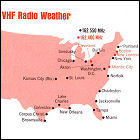 The U.S. Weather Bureau announces plans to expand its Weather Radio service across the country, with forecasts now prepared and worded for public consumption (as opposed to the service’s original 1950s mission of providing weather information for airline pilots). Concentrated primarily in coastal areas and a handful of inland population centers, the Weather Radio network has yet to become the Bureau’s primary means of disseminating emergency weather information, a mission it won’t take on until the 1970s.
The U.S. Weather Bureau announces plans to expand its Weather Radio service across the country, with forecasts now prepared and worded for public consumption (as opposed to the service’s original 1950s mission of providing weather information for airline pilots). Concentrated primarily in coastal areas and a handful of inland population centers, the Weather Radio network has yet to become the Bureau’s primary means of disseminating emergency weather information, a mission it won’t take on until the 1970s.
The Emergency Broadcast System
 Radio and television stations across the United States begin mandatory participation in the national Emergency Broadcast System, a nationwide civil defense alert network replacing the CONELRAD system of the 1950s. Much like CONELRAD, EBS tests and activations initially require the rapid shutdown and reactivation of transmitters, at least until that practice is abolished in favor of a two-tone warning sound in the 1970s. Though the switch from CONELRAD to EBS is sparked by the 1962 Cuban Missile Crisis, the EBS will later become more closely associated with severe weather warnings.
Radio and television stations across the United States begin mandatory participation in the national Emergency Broadcast System, a nationwide civil defense alert network replacing the CONELRAD system of the 1950s. Much like CONELRAD, EBS tests and activations initially require the rapid shutdown and reactivation of transmitters, at least until that practice is abolished in favor of a two-tone warning sound in the 1970s. Though the switch from CONELRAD to EBS is sparked by the 1962 Cuban Missile Crisis, the EBS will later become more closely associated with severe weather warnings.
CONELRAD
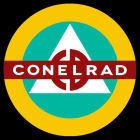 As a response to early Soviet atomic weapon tests, President Truman orders the initiation of the nationwide CONELRAD (Control of Electromagnetic Radiation) system, designed to limit the number of actively broadcasting radio stations whose signals could be used by enemy bombers to home in on and attack population centers. Designated AM radio stations would pass along emergency signals to smaller stations downstream, which would then begin a complex cycle of broadcasting emergency information to the public and then shutting down to allow another station to broadcast the same information; it is hoped that the rapidly shifting radio signals will prevent an invading enemy from finding viable targets. With its operating strategy assuming nuclear-armed Soviet bombers, CONELRAD will be rendered obsolete by the rise of the intercontinental ballistic missile by the end of the decade, and will be replaced by the Emergency Broadcast system in 1963.
As a response to early Soviet atomic weapon tests, President Truman orders the initiation of the nationwide CONELRAD (Control of Electromagnetic Radiation) system, designed to limit the number of actively broadcasting radio stations whose signals could be used by enemy bombers to home in on and attack population centers. Designated AM radio stations would pass along emergency signals to smaller stations downstream, which would then begin a complex cycle of broadcasting emergency information to the public and then shutting down to allow another station to broadcast the same information; it is hoped that the rapidly shifting radio signals will prevent an invading enemy from finding viable targets. With its operating strategy assuming nuclear-armed Soviet bombers, CONELRAD will be rendered obsolete by the rise of the intercontinental ballistic missile by the end of the decade, and will be replaced by the Emergency Broadcast system in 1963.
Weather Radio: all weather, all the time
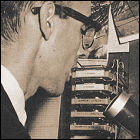 The U.S. Weather bureau signs on radio station KWO35, located at New York’s La Guardia Airport, broadcasting weather forecasts primarily for the benefit of pilots. Not targeted for public consumption, the experimental station broadcasts for several hours a day at a frequency of 162.55Mhz, outside of the spectrum reserved for FM radio. A similar station on the same frequency will later sign on at Chicago’s O’Hare Airport in 1953, again mainly for the consumption of airline pilots. Marine forecasts are added later, and the system helps the Weather Bureau prevent its local forecasters from being overwhelmed by requests for “personalized” weather reports for pilots. These two stations are the precursor for the nationwide weather radio network operated by the Weather Bureau’s successor agency, the National Weather Service.
The U.S. Weather bureau signs on radio station KWO35, located at New York’s La Guardia Airport, broadcasting weather forecasts primarily for the benefit of pilots. Not targeted for public consumption, the experimental station broadcasts for several hours a day at a frequency of 162.55Mhz, outside of the spectrum reserved for FM radio. A similar station on the same frequency will later sign on at Chicago’s O’Hare Airport in 1953, again mainly for the consumption of airline pilots. Marine forecasts are added later, and the system helps the Weather Bureau prevent its local forecasters from being overwhelmed by requests for “personalized” weather reports for pilots. These two stations are the precursor for the nationwide weather radio network operated by the Weather Bureau’s successor agency, the National Weather Service.